Birds of Mallorca in taxonomic hierarchy
Purple heron / Purpurreiher (Ardea purpurea)
Profile Wikipedia eBird Vogelwarte BirdLife ZH ornitho.ch Xeno-Canto BirdID NABU
Purple heron, Phnom Krom. 2024-03-03 06.13.38 Cambodia
First observed in Cambodia on 2024-03-03.
General: ![]() The purple heron (Ardea purpurea) is a wide-ranging species of wading bird in the heron family, Ardeidae. The scientific name comes from Latin ardea "heron", and purpureus, "coloured purple".[2] It breeds in Africa, central and southern Europe, and southern and eastern Asia. The Western Palearctic populations migrate between breeding and wintering habitats whereas the African and tropical-Asian populations are primarily sedentary, except for occasional dispersive movements.
[more]
The purple heron (Ardea purpurea) is a wide-ranging species of wading bird in the heron family, Ardeidae. The scientific name comes from Latin ardea "heron", and purpureus, "coloured purple".[2] It breeds in Africa, central and southern Europe, and southern and eastern Asia. The Western Palearctic populations migrate between breeding and wintering habitats whereas the African and tropical-Asian populations are primarily sedentary, except for occasional dispersive movements.
[more]
Vocalization: ![]() Quite similar to Grey Heron, but not so vocal. [Link]
Quite similar to Grey Heron, but not so vocal. [Link]
Calls: ![]() Pitch slightly higher and remains stable throughout the short call. Volume muffled and timbre drier. [Link]
Pitch slightly higher and remains stable throughout the short call. Volume muffled and timbre drier. [Link]
Physical details: length=78-90 cm,
wingspan=120-150 cm,
weight=525-1218 g
Habitats:
Wetland
Call:
Automatically generated from Xeno-Canto recording
♫ XC878038 - Purple Heron - Ardea purpurea manilensis - flight call - Nonthaburi, Thailand. Source: XENOCANTO
XC878038 - Purple Heron - Ardea purpurea manilensis - flight call - Nonthaburi, Thailand.mp3
Thailand (flight call)
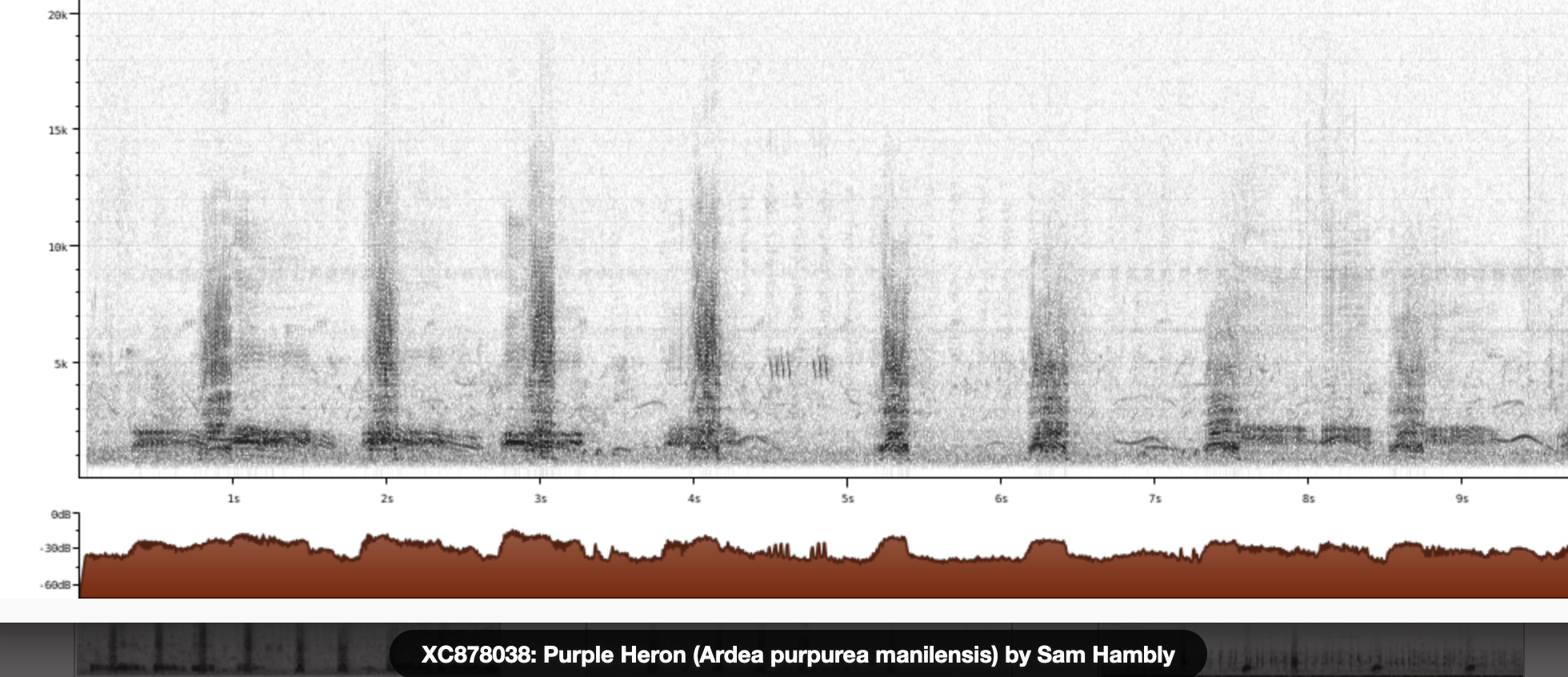
Call attributes:
flight call Frequency: ,
Black-crowned night-heron / Nachtreiher (Nycticorax nycticorax)

Wikipedia: Black-crowned night-heron Source: OTHER
1200px-BCNH_CMCNJ_for_Wiki.png
This bird appears across the great seas in the following continents:
Europe, North America, South America, Africa, Asia.
General: ![]() The black-crowned night heron (Nycticorax nycticorax), or black-capped night heron, commonly shortened to just night heron in Eurasia, is a medium-sized heron found throughout a large part of the world, except in the coldest regions and Australasia (where it is replaced by the closely related nankeen night heron, with which it has hybridized in the area of contact).
[more]
The black-crowned night heron (Nycticorax nycticorax), or black-capped night heron, commonly shortened to just night heron in Eurasia, is a medium-sized heron found throughout a large part of the world, except in the coldest regions and Australasia (where it is replaced by the closely related nankeen night heron, with which it has hybridized in the area of contact).
[more]
Calls: ![]() Most commonly hear call is a nasal, soft croaking "roack", like cross between Raven and frog. [Link]
Most commonly hear call is a nasal, soft croaking "roack", like cross between Raven and frog. [Link]
Physical details: length=58-65 cm,
wingspan=105-112 cm,
weight=500-800 g
Habitats:
Wetland
Little egret / Seidenreiher (Egretta garzetta)
Profile Wikipedia eBird Vogelwarte BirdLife ZH ornitho.ch Xeno-Canto BirdID NABU
Seidenreiher. 2022-02-05 11.42.26 Klingnauer Stausee (man-made lake)
First observed in 🇨🇭 on 2022-02-05.
General: ![]() The little egret (Egretta garzetta) is a species of small heron in the family Ardeidae. The genus name comes from the Provençal French Aigrette, "egret", a diminutive of Aigron," heron". The species epithet garzetta is from the Italian name for this bird, garzetta or sgarzetta.[2]
[more]
The little egret (Egretta garzetta) is a species of small heron in the family Ardeidae. The genus name comes from the Provençal French Aigrette, "egret", a diminutive of Aigron," heron". The species epithet garzetta is from the Italian name for this bird, garzetta or sgarzetta.[2]
[more]
Vocalization: ![]() Sometimes utters a dry, rasping "kerrr" when flushed, but is mostly silent away from breeding ground. In colonies a peculiar gurgling and vibrating sound is heard; "ghala-la-la-la". [Link]
Sometimes utters a dry, rasping "kerrr" when flushed, but is mostly silent away from breeding ground. In colonies a peculiar gurgling and vibrating sound is heard; "ghala-la-la-la". [Link]
Physical details: length=55-65 cm,
wingspan=88-95 cm,
weight=350-550 g
Habitats:
Wetland
Song:
Automatically generated from Xeno-Canto recording
Song attributes:
Frequency:
♫ XC799679 - Little Egret - Egretta garzetta - call that sounds like its vomiting - Catalunya, Spain. Source: XENOCANTO
XC799679 - Little Egret - Egretta garzetta - call that sounds like its vomiting - Catalunya, Spain.mp3
Spain (call)
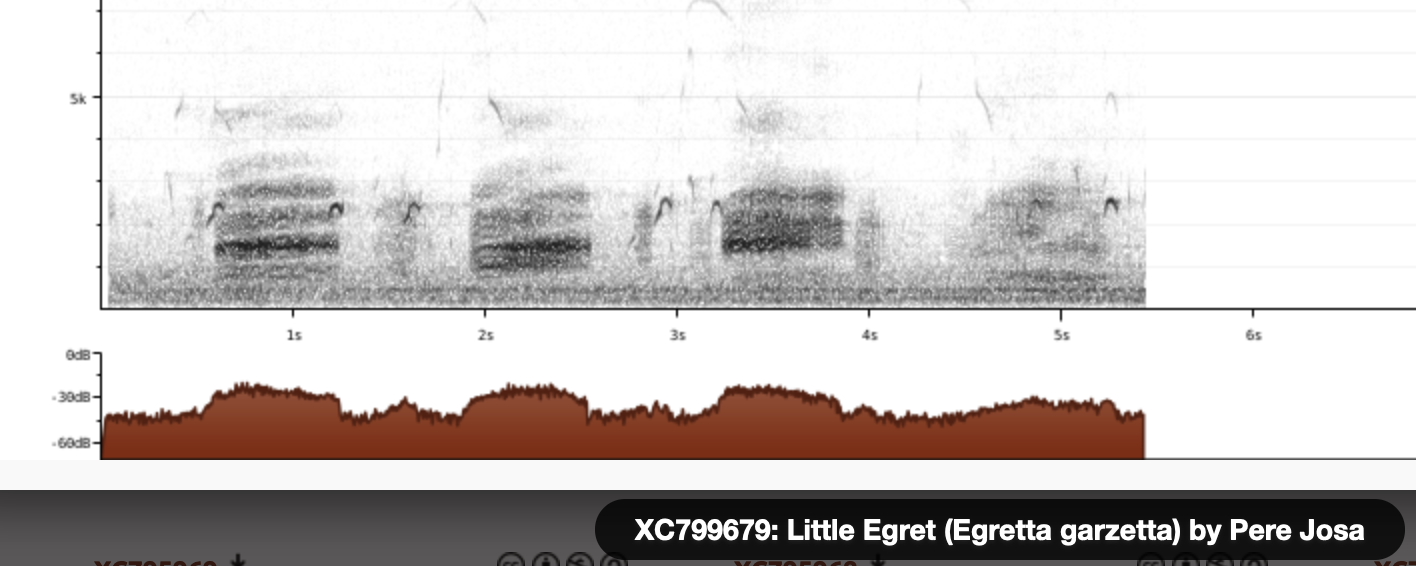
Call:
Sort of a quack, brighter and higher than grey heron, with a bit of wawa.
Call attributes:
Call melody: non-musical, slow, Frequency: low (1-3 KHz),
Little bittern / Zwergdommel (Ixobrychus minutus)
Profile Wikipedia eBird Vogelwarte BirdLife ZH ornitho.ch bird-song.ch Xeno-Canto BirdID NABU
Zwergdommel Weibchen (gestreift), Neeracherried. 2022-09-04 09.00.22 Neeracherried
First observed in 🇨🇭 on 2022-09-04.
General: ![]() The little bittern or common little bittern (Ixobrychus minutus) is a wading bird in the heron family, Ardeidae. Ixobrychus is from Ancient Greek ixias, a reed-like plant and brukhomai, to bellow, and minutus is Latin for "small".[2]
[more]
The little bittern or common little bittern (Ixobrychus minutus) is a wading bird in the heron family, Ardeidae. Ixobrychus is from Ancient Greek ixias, a reed-like plant and brukhomai, to bellow, and minutus is Latin for "small".[2]
[more]
Vocalization: ![]() Mostly silent except in breeding season. [Link]
Mostly silent except in breeding season. [Link]
Song: ![]() Song is a series of short, deep, frog-like "gorrk", repeated every 2 seconds. Tone is muffled and hollow, but far-carrying. [Link]
Song is a series of short, deep, frog-like "gorrk", repeated every 2 seconds. Tone is muffled and hollow, but far-carrying. [Link]
Calls: ![]() Flight-call a sharp "ki-ke-ke" or a nasal "ke". [Link]
Flight-call a sharp "ki-ke-ke" or a nasal "ke". [Link]
Physical details: length=33-38 cm,
wingspan=52-58 cm,
weight=140-150 g
Habitats:
Wetland
Call:
Almost a bark, low-pitched, little treble.
Call attributes:
Call melody: non-musical, slow, Frequency: low (1-3 KHz),

Wikipedia: Moustached warbler Source: OTHER
1200px-Acrocephalus_melanopogon_ad03_CB.jpg
General: ![]() The moustached warbler (Acrocephalus melanopogon) is an Old World warbler in the genus Acrocephalus. It breeds in southern Europe and southern temperate Asia with a few in north-west Africa. It is partially migratory. South west European birds are resident, south east European birds winter in the Mediterranean breeding range, and the Asiatic race migrates to Arabia, India and Pakistan.
[more]
The moustached warbler (Acrocephalus melanopogon) is an Old World warbler in the genus Acrocephalus. It breeds in southern Europe and southern temperate Asia with a few in north-west Africa. It is partially migratory. South west European birds are resident, south east European birds winter in the Mediterranean breeding range, and the Asiatic race migrates to Arabia, India and Pakistan.
[more]
Song: ![]() Song most resembling that of Reed Warbler (A, scirpaceus), but often includes diagnostic (unique among congeners), pure-sounding note sequence resembling crescendo of Common Nightingale (L. megarhynchos), before launching into typical Acrocephalus sounding song. This latter type can be sustained for some time without the diagnostic sequence and is more difficult to distinguish from A. scirpaceus. Note faster tempo and more variation. [Link]
Song most resembling that of Reed Warbler (A, scirpaceus), but often includes diagnostic (unique among congeners), pure-sounding note sequence resembling crescendo of Common Nightingale (L. megarhynchos), before launching into typical Acrocephalus sounding song. This latter type can be sustained for some time without the diagnostic sequence and is more difficult to distinguish from A. scirpaceus. Note faster tempo and more variation. [Link]
Calls: ![]() Contact call a dry "trrrt", similar to corresponding call of Sedge Warbler. [Link]
Contact call a dry "trrrt", similar to corresponding call of Sedge Warbler. [Link]
Physical details: length=12-13 cm,
wingspan=15-16 cm,
weight=10-14 g
General: ![]() Balearic warbler (Curruca balearica) is a typical warbler, genus Curruca. It is endemic to the Balearic Islands, apart
from Menorca. It groups with the Marmora's warbler, Tristram's warbler and the Dartford warbler (Helbig 2001, Jønsson & Fjeldså 2006).
[more]
Balearic warbler (Curruca balearica) is a typical warbler, genus Curruca. It is endemic to the Balearic Islands, apart
from Menorca. It groups with the Marmora's warbler, Tristram's warbler and the Dartford warbler (Helbig 2001, Jønsson & Fjeldså 2006).
[more]
Sardinian warbler seen from out terrace at Calo dOr, Mallorca. 2022-04-08 09.18.40 Mallorca
First observed in Mallorca on 2022-04-07.
![]() Die Samtkopf-Grasmücke (Sylvia melanocephala) ist ein Singvogel aus der Gattung der Grasmücken (Sylvia). Sie kommt im Mittelmeerraum vor, ist wenig scheu und zeigt sich oft.
[more]
Die Samtkopf-Grasmücke (Sylvia melanocephala) ist ein Singvogel aus der Gattung der Grasmücken (Sylvia). Sie kommt im Mittelmeerraum vor, ist wenig scheu und zeigt sich oft.
[more]
Song: ![]() Epitome of mediterranean sylvias, and learning the songs of the genus should start with extensive listening to this species (use xeno-canto link below). Song a stream of varied, short notes, constantly interspersed with variations of the scolding call. Phrases 2-5 sec. long. Easily confused with several other sylvias, especially in the eastern part of the Mediterranean. Rattling sound (in both song and call) differs from most other congeners by being considerably harder and more "smacking". [Link]
Epitome of mediterranean sylvias, and learning the songs of the genus should start with extensive listening to this species (use xeno-canto link below). Song a stream of varied, short notes, constantly interspersed with variations of the scolding call. Phrases 2-5 sec. long. Easily confused with several other sylvias, especially in the eastern part of the Mediterranean. Rattling sound (in both song and call) differs from most other congeners by being considerably harder and more "smacking". [Link]
Calls: ![]() Scolding call a machinegun-like, short and harsh rattle. Usually consisting of 2-5 notes with some variation in timbre and delivery. Dartford Warbler most similar, but usually betrays itself by it's characteristic and frequently used contact call (also interspersed when singing). [Link]
Scolding call a machinegun-like, short and harsh rattle. Usually consisting of 2-5 notes with some variation in timbre and delivery. Dartford Warbler most similar, but usually betrays itself by it's characteristic and frequently used contact call (also interspersed when singing). [Link]
Physical details: length=13 cm,
wingspan=15-18 cm,
weight=10-15 g
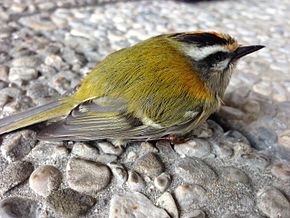
Wikipedia Sommergoldhaehnchen (Regulus ignicapilla) weiblich. Source: WIKIPEDIA
Wikipedia Sommergoldhaehnchen_(Regulus_ignicapilla) weiblich.jpg
First observed in 🇨🇭 on 2020-05-09.
General: ![]() The common firecrest (Regulus ignicapilla), also known as the firecrest, is a very small passerine bird in the kinglet family. It breeds in most of temperate Europe and northwestern Africa, and is partially migratory, with birds from central Europe wintering to the south and west of their breeding range. Firecrests in the Balearic Islands and north Africa are widely recognised as a separate subspecies, but the population on Madeira, previously also treated as a subspecies, is now treated as a distinct species, the Madeira firecrest, Regulus madeirensis. A fossil ancestor of the firecrest has been identified from a single wing bone.
[more]
The common firecrest (Regulus ignicapilla), also known as the firecrest, is a very small passerine bird in the kinglet family. It breeds in most of temperate Europe and northwestern Africa, and is partially migratory, with birds from central Europe wintering to the south and west of their breeding range. Firecrests in the Balearic Islands and north Africa are widely recognised as a separate subspecies, but the population on Madeira, previously also treated as a subspecies, is now treated as a distinct species, the Madeira firecrest, Regulus madeirensis. A fossil ancestor of the firecrest has been identified from a single wing bone.
[more]
Vocalization: ![]() A slow crescendo of short "tze" sounds in a phrase rising slightly in pitch, without the repeated arpeggiated movements of goldcrest. [Link]
A slow crescendo of short "tze" sounds in a phrase rising slightly in pitch, without the repeated arpeggiated movements of goldcrest. [Link]
Song: ![]() Wie [beim Wintergoldhähnchen] aber auf gleicher Tonhöhe bleibend. [Link]
Wie [beim Wintergoldhähnchen] aber auf gleicher Tonhöhe bleibend. [Link]
![]() Song: Similar in timbre to Goldcrest, but much more monotonous. [Link]
Song: Similar in timbre to Goldcrest, but much more monotonous. [Link]
Calls: ![]() „sisisi“ [Link]
„sisisi“ [Link]
![]() Call: a thin "tsi tsi tsi" similar to Goldcrest, but not so sharp. [Link]
Call: a thin "tsi tsi tsi" similar to Goldcrest, but not so sharp. [Link]
Physical details: length=9 cm,
wingspan=13-16 cm,
weight=4-6 g
Habitats:
Forest
Song:
Very high rhythmic repetition of about 3 seconds
Song attributes:
Melody: simple rhythmic, fast, Frequency: 6-8 KHz
Thekla's lark in the countryside near Es Trenc, Mallorca. 2022-04-08 14.48.26 Mallorca
First observed in Mallorca on 2022-04-08.
General: ![]() Thekla's lark (Galerida theklae), also known as the Thekla lark, is a species of lark that breeds on the Iberian Peninsula, in northern Africa, and sub-Saharan Africa from Senegal to Somalia. It is a sedentary (non-migratory) species. This is a common bird of dry open country, often at some altitude. Thekla's lark was named by Alfred Edmund Brehm in 1857 for his recently deceased sister Thekla Brehm (1833–1857). The name is a modern Greek one, Θέκλα (Thekla), which comes from ancient Greek Θεόκλεια (Theokleia) derived from θεός (theos, "god") and κλέος (kleos, "glory" or "honour").[2] The population is declining in Spain, but this is a common bird with a very wide range and the International Union for Conservation of Nature has rated its conservation status as being of "least concern".[1]
[more]
Thekla's lark (Galerida theklae), also known as the Thekla lark, is a species of lark that breeds on the Iberian Peninsula, in northern Africa, and sub-Saharan Africa from Senegal to Somalia. It is a sedentary (non-migratory) species. This is a common bird of dry open country, often at some altitude. Thekla's lark was named by Alfred Edmund Brehm in 1857 for his recently deceased sister Thekla Brehm (1833–1857). The name is a modern Greek one, Θέκλα (Thekla), which comes from ancient Greek Θεόκλεια (Theokleia) derived from θεός (theos, "god") and κλέος (kleos, "glory" or "honour").[2] The population is declining in Spain, but this is a common bird with a very wide range and the International Union for Conservation of Nature has rated its conservation status as being of "least concern".[1]
[more]
Song: ![]() Song: a mix of long whistling, warbling sounds, trills and mimicry. Full song very similar to Crested Lark. Rudiments of song are often heard and is less whistling than Crested. [Link]
Song: a mix of long whistling, warbling sounds, trills and mimicry. Full song very similar to Crested Lark. Rudiments of song are often heard and is less whistling than Crested. [Link]
Calls: ![]() The contact call/alarm-call may be the best characteristic to separate it from Crested Lark where both species occur. Thekla Lark calls with 3-5 syllables, of which one is often drawn out and "hangs" while falling in pitch, giving it a melancholic feeling (diagnostic). The phrase has a more "bouncing" feel to it than Crested Lark. [Link]
The contact call/alarm-call may be the best characteristic to separate it from Crested Lark where both species occur. Thekla Lark calls with 3-5 syllables, of which one is often drawn out and "hangs" while falling in pitch, giving it a melancholic feeling (diagnostic). The phrase has a more "bouncing" feel to it than Crested Lark. [Link]
Physical details: length=17 cm,
wingspan=28-32 cm,
weight=31-42 g
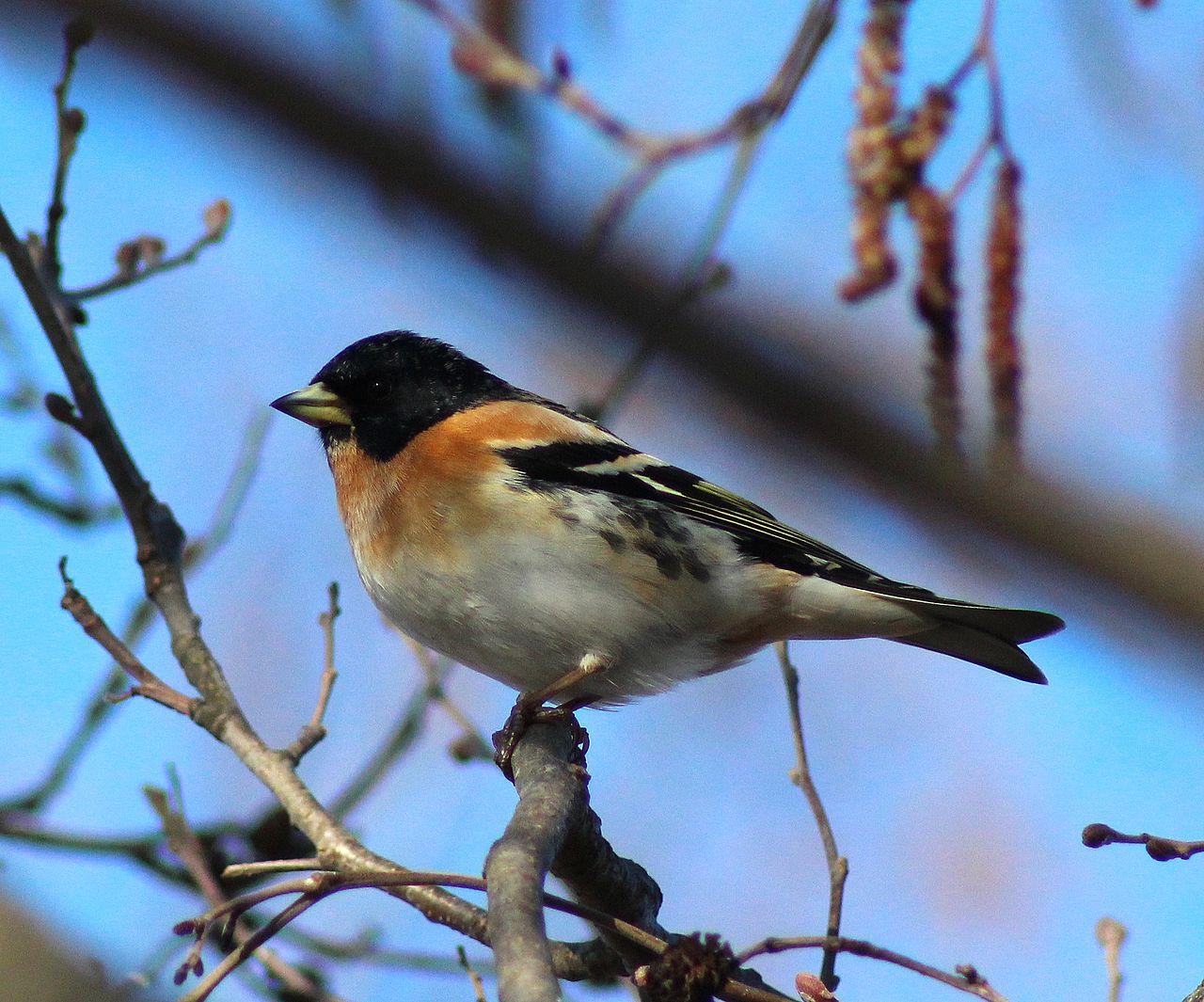
Wikipedia Bergfink. Foto: Source: WIKIPEDIA
Wikipedia Bergfink.jpg
This bird appears across the great seas in the following continents:
Europe, North America, Africa.
Geography: ![]() the Brambling appears regularly in small numbers in Alaska during migration, straying the short distance across the Bering Sea. Some of those that stray across in autumn apparently then continue south on the American side, and there have been winter records for numerous states and provinces east to the Atlantic Coast and south to Colorado. Many of these vagrant Bramblings have been found visiting bird feeders. [Link]
the Brambling appears regularly in small numbers in Alaska during migration, straying the short distance across the Bering Sea. Some of those that stray across in autumn apparently then continue south on the American side, and there have been winter records for numerous states and provinces east to the Atlantic Coast and south to Colorado. Many of these vagrant Bramblings have been found visiting bird feeders. [Link]
Vocalization: ![]() Large repertoire of mostly characteristic sounds. [Link]
Large repertoire of mostly characteristic sounds. [Link]
Song: ![]() Song very distinct; a soft, wheezing, drawn-out single note. Repeated at the same pitch in a monotonous manner. [Link]
Song very distinct; a soft, wheezing, drawn-out single note. Repeated at the same pitch in a monotonous manner. [Link]
Calls: ![]() Contact calls include a short, nasal, ascending "keeaa", a short high-pitched, piercing "tzeet" and a linnet-like "chepp". May be mistaken for Greenfinch, but note softer timbre and stable pitch throughout the call. [Link]
Contact calls include a short, nasal, ascending "keeaa", a short high-pitched, piercing "tzeet" and a linnet-like "chepp". May be mistaken for Greenfinch, but note softer timbre and stable pitch throughout the call. [Link]
Physical details: length=14 cm,
wingspan=25-26 cm,
weight=17-30 g
Habitats:
Forest
Song:
General: Bergfink - call cheep plus two ascending Grünfink squawks. Song? Grünfink squawk but not descending, every 3-4 seconds.
Song: ![]() Song very distinct; a soft, wheezing, drawn-out single note. Repeated at the same pitch in a monotonous manner. [Link]
Song very distinct; a soft, wheezing, drawn-out single note. Repeated at the same pitch in a monotonous manner. [Link]
Song attributes:
Melody: simple rhythmic, slow, Frequency: medium (1-5 KHz) Special sounds: rasp Singing season: 04-14 - 09-15
♫ Source: XENOCANTO
XC731031 - Brambling - Fringilla montifringilla.mp3
(song)
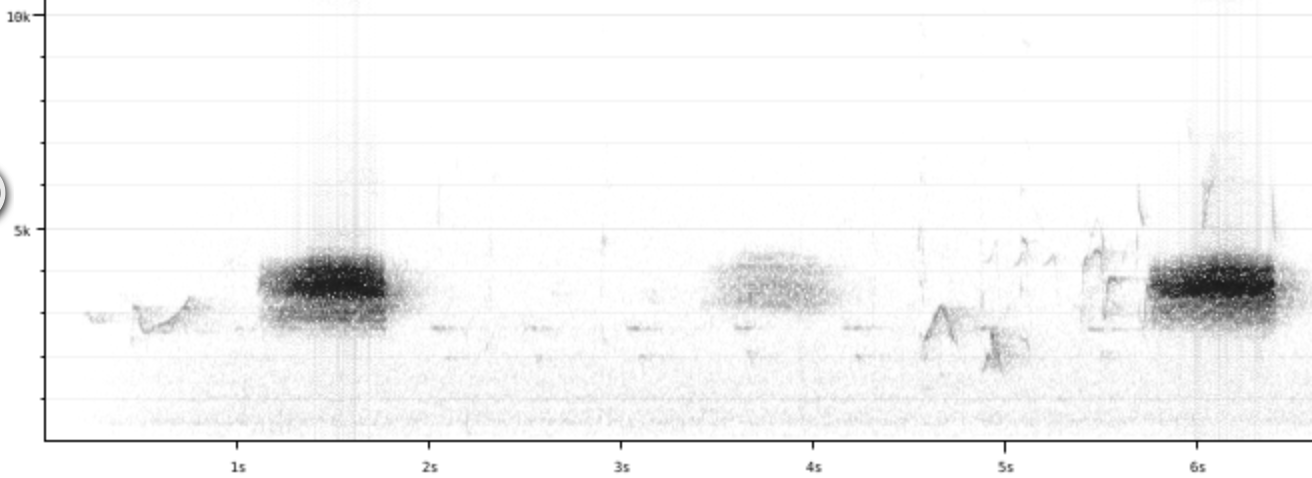

Wikimedia Red Crossbills (Male). Source: WIKIPEDIA
Wikimedia Red_Crossbills_(Male).jpg
First observed in 🇨🇭 on 2020-06-13.
This bird appears across the great seas in the following continents:
Europe, North America, Africa.
Forests with conifers. Some spend the winter in Switzerland, others are here year-round.
Appearance and identification: ![]() Nabu.de: das Männchen schon von weitem durch seine ziegelrote Farbe auf. Das Weibchen dagegen ist unscheinbar graugrün gefärbt.Größe: 15 bis 17 Zentimeter
Zugtyp: Teilzieher
Beobachtungszeitraum: Oktober bis April, im Mittelgebirge und Alpenraum ganzjährig. [Link]
Nabu.de: das Männchen schon von weitem durch seine ziegelrote Farbe auf. Das Weibchen dagegen ist unscheinbar graugrün gefärbt.Größe: 15 bis 17 Zentimeter
Zugtyp: Teilzieher
Beobachtungszeitraum: Oktober bis April, im Mittelgebirge und Alpenraum ganzjährig. [Link]
![]() New research suggests that there may be as many as eight different full species of Red Crossbills on [North America]. [Link]
New research suggests that there may be as many as eight different full species of Red Crossbills on [North America]. [Link]
Behavior: ![]() Wikipedia: a small passerine bird in the finch family Fringillidae, also known as the Common Crossbill in Eurasia. Crossbills have distinctive mandibles, crossed at the tips, which enable them to extract seeds from conifer cones and other fruits. [Link]
Wikipedia: a small passerine bird in the finch family Fringillidae, also known as the Common Crossbill in Eurasia. Crossbills have distinctive mandibles, crossed at the tips, which enable them to extract seeds from conifer cones and other fruits. [Link]
Song: ![]() The song consist of improvised, resonant twittering, and series of contact calls with no apparent phrases. It is generally faster, with less marked pauses than in Parrot Crossbill, and the phrasing seems more random. [Link]
The song consist of improvised, resonant twittering, and series of contact calls with no apparent phrases. It is generally faster, with less marked pauses than in Parrot Crossbill, and the phrasing seems more random. [Link]
Calls: ![]() Contact call similar to Parroy Crossbill's "tupp", but is on average higher and less powerful, with a "cut-off" ending. In sum: Parrot Crossbill; hard attack, soft ending, Crossbill: softer attack, cut-off ending. Beware regional variations and overlap in pitch of calls with Parrot. [Link]
Contact call similar to Parroy Crossbill's "tupp", but is on average higher and less powerful, with a "cut-off" ending. In sum: Parrot Crossbill; hard attack, soft ending, Crossbill: softer attack, cut-off ending. Beware regional variations and overlap in pitch of calls with Parrot. [Link]
Physical details: length=16 cm,
wingspan=27-30 cm,
weight=35-50 g
Habitats:
Forest
Song:
Repeated hi-low pattern...well, doesn't always sound like that.
The very short beginning of my Stazersee recording before the static sets in does,
as well as a song found online.
One recording reminds me of cicada sounds.
Song attributes:
Melody: stereotype melodic, slow, Frequency: 2-10 KHz
Profile Wikipedia eBird Vogelwarte BirdLife ZH ornitho.ch Xeno-Canto BirdID NABU
Zaunammer in den Reben bei Maienfeld. 2021-05-29 08.48.26 Maienfeld
First observed in 🇨🇭 on 2021-05-29.
Als Anfänger, hätte ich gedacht, dies wäre eine Goldammer, da beide gelb mit braunen Details sind; BirdID meint sie sind kompakter. Das Männchen ist eher gelb und hat was für mich wie drei brauen Streifen im Gesicht aussehen. Die Goldammer hat kaum braun am Kopf. Das Weibchen ist weniger gelb und mehr braun. Siehe BirdID für gute Bilder und Beschreibung der Erkennungsmerkmale.
BirdID says song like yellowhammer with no ending. I see what they mean - it's more like 16 or so trilled repetitions of the same note, and no leap up to 'lieb' as in the German Goldammer mnemonic.
Song: ![]() Wie Goldammer, aber ohne das „lieb“.und etwas tiefer. Ähnlich Klappergrasmücke.
[Link]
Wie Goldammer, aber ohne das „lieb“.und etwas tiefer. Ähnlich Klappergrasmücke.
[Link]
![]() Song variable, but can generally be described as a Yellowhammer phrase with no ending, or an Arctic Warbler with bunting timbre. Tempo also variable, but rhythm always even. [Link]
Song variable, but can generally be described as a Yellowhammer phrase with no ending, or an Arctic Warbler with bunting timbre. Tempo also variable, but rhythm always even. [Link]
Calls: ![]() Sehr ähnlich denen der obigen Art [Goldammer].
[Link]
Sehr ähnlich denen der obigen Art [Goldammer].
[Link]
![]() Alarm call a thin "tseeep", similar to Rock Bunting, but more drawn out. [Link]
Alarm call a thin "tseeep", similar to Rock Bunting, but more drawn out. [Link]
Physical details: length=15 cm,
wingspan=22-25 cm,
weight=21-29 g
Habitats:
Agricultural
Song:
biologie-wissen.info: sings beg Feb to mid July; me: long trill similar to yellowhammer
Song attributes:
Melody: simple rhythmic, fast, Frequency: 3-6 KHz
General: ![]() The pink-headed warbler (Cardellina versicolor) is a small passerine bird found in the southwestern highlands of Guatemala and the central and southeastern highlands of the Mexican state of Chiapas. The adult is primarily red, with a silvery-pink head and chest. It is a fairly common to common resident of humid to semi-humid pine-oak, pine-evergreen and evergreen forest and edge, at altitudes ranging from 1,800–3,500 m (5,900–11,500 ft) above sea level.
[more]
The pink-headed warbler (Cardellina versicolor) is a small passerine bird found in the southwestern highlands of Guatemala and the central and southeastern highlands of the Mexican state of Chiapas. The adult is primarily red, with a silvery-pink head and chest. It is a fairly common to common resident of humid to semi-humid pine-oak, pine-evergreen and evergreen forest and edge, at altitudes ranging from 1,800–3,500 m (5,900–11,500 ft) above sea level.
[more]
Common blackbird / Amsel (Turdus merula)

Amsel bei friedliweid. 2020-04-13 10.28.42 Friedliweid
First observed in Australia on 2008-01-01.
The first bird I loved listening to
Song: ![]() Melodisch flötend dazwischen auch zerquetschte Töne. Die Elemente werden nicht wiederholt. Singt von Singwarte aus. Ca. 100 verschiedene Strophentypen.
[Link]
Melodisch flötend dazwischen auch zerquetschte Töne. Die Elemente werden nicht wiederholt. Singt von Singwarte aus. Ca. 100 verschiedene Strophentypen.
[Link]
![]() One of the most appreciated song birds. Very melodious and resonant, with long mellow notes and a large register. Less high pitched sounds than Song Thrush, and seldom repeats a phrase. Timbre fuller than both Song Thrush and Mistle Thrush. Well defined pauses between phrases, giving the song a relaxed pace. [Link]
One of the most appreciated song birds. Very melodious and resonant, with long mellow notes and a large register. Less high pitched sounds than Song Thrush, and seldom repeats a phrase. Timbre fuller than both Song Thrush and Mistle Thrush. Well defined pauses between phrases, giving the song a relaxed pace. [Link]
Calls: ![]() Je nach Situation, „duck duck duck“, „tix-tix-tix“ in rascher Folge, „srieh“ (auch als Flugwarnruf)
[Link]
Je nach Situation, „duck duck duck“, „tix-tix-tix“ in rascher Folge, „srieh“ (auch als Flugwarnruf)
[Link]
![]() Large repertoire of calls. Most characteristic is a hysterical rattle often given when flushed. Sometimes preceded by a hard "tok tok", which then accelerates into a panicky arpeggio-like crescendo. Contact call a thin redwing-like "srrreee". Alarm calls: a sharp "tink, tink" or a very high pitch falling whistle. [Link]
Large repertoire of calls. Most characteristic is a hysterical rattle often given when flushed. Sometimes preceded by a hard "tok tok", which then accelerates into a panicky arpeggio-like crescendo. Contact call a thin redwing-like "srrreee". Alarm calls: a sharp "tink, tink" or a very high pitch falling whistle. [Link]
Physical details: length=24-25 cm,
wingspan=34-38 cm,
weight=80-125 g
Habitats:
Settlement
Song:
Other: Gut zu erkennen ist die Amsel.
Sie singt melodiös, erklärt Heller, «zuerst flötend und dann gegen Schluss so schnirpslig».
Die Amsel singe gerne dort, wo sie gut gehört werde, etwa vor Hauswänden, die den Schall nicht schlucken.
Ich wollte schauen was schnirpslig heisst, aber diese ist diese einzige Verwendung, die Google kennt!
Der flötende Teil ist relativ tief, 1.5-3 KHz, der schnirpslige aber 2.5-7 KHz.
(Schnirpslig ist ein schones Wort das der Redner erfunden hat - Google findet nur diese eine Webseite mit dem Wort!) [Von der SRF Webseite:]
Song attributes:
Melody: improvised melodic (lmh), slow, Frequency: 1-7 KHz Special sounds: flourish Singing season: 02-01 - 07-31 Dawn chorus start, 45 minutes before dawn.
♫ Repetitiver, einfallsloser Amsel den ich für einen Misteldrossel gehalten habe, dazu eine Kohlemeise der lmh singt und ich mit einer Tannen-meise gewechselt habe. ![]() Source: Zoom H6 2023-02-23 17.40.48 (song)
Source: Zoom H6 2023-02-23 17.40.48 (song)
Call:
Loud falling series of notes, unlike anything else you hear from a blackbird
Call attributes:
alarm call Call melody: simple rhythmic, slow, Frequency: medium (1-5 KHz),
Blue rock-thrush / Blaumerle (Monticola solitarius)
MerlinBirdID schlaegt Blaumerle vor, koennte aber genauso gut in Kaltbrunnerriet ein Amsel sein. 2022-06-04 12.05.18 Kaltbrunner-Riet
First observed in Mallorca on 2022-04-07.
General: ![]() The blue rock thrush (Monticola solitarius) is a species of chat. This thrush-like Old World flycatcher was formerly placed in the family Turdidae. It breeds in southern Europe, northwest Africa, and from Central Asia to northern China and Malaysia. The blue rock thrush is the official national bird of Malta and was shown on the Lm 1 coins that were part of the country's former currency.
[more]
The blue rock thrush (Monticola solitarius) is a species of chat. This thrush-like Old World flycatcher was formerly placed in the family Turdidae. It breeds in southern Europe, northwest Africa, and from Central Asia to northern China and Malaysia. The blue rock thrush is the official national bird of Malta and was shown on the Lm 1 coins that were part of the country's former currency.
[more]
Habitats:
Mountain
Song:
Pretty short up-and-down song heard in Mallorca
Song attributes:
Melody: stereotype melodic, fast, Frequency: 2-4 KHz
♫ Source: XENOCANTO
XC659831 - Blue Rock Thrush - Monticola solitarius - song is a variable up and down - recorded in France.mp3
(song)

Bluethroat / Blaukehlchen (Luscinia svecica)
I had an ID via app for an immature or female bluethroat - which has no blue throat, but long legs and a relatively short tail in comparison - could be this. 2024-02-17 07.02.22 Laos
First observed in Laos on 2024-02-17.
Looking for it in Kaltbrunnenriet - didn't find it in June 2022.
Sparrow-brown head, then strong blue, orange-brown, blue,dark brown, orange-brown, ending in a white belly!
Song: ![]() Song: Structure slightly similar to Nightingale, but tone much thinner and less full-bodied. A good impersonator and various imitations are interwoven among metallic, ringing sounds to form a complex, intriguing song. [Link]
Song: Structure slightly similar to Nightingale, but tone much thinner and less full-bodied. A good impersonator and various imitations are interwoven among metallic, ringing sounds to form a complex, intriguing song. [Link]
Calls: ![]() Call: "pju-check". Double syllable starting as a descending whistle, and ending on a short "check". [Link]
Call: "pju-check". Double syllable starting as a descending whistle, and ending on a short "check". [Link]
Physical details: length=14 cm,
wingspan=20-22 cm,
weight=15-25 g
Habitats:
Wetland
Song:
Often one little phrase or even a single note repeated, a bit like a nightingale? Occasional figaro?
Song attributes:
Melody: improvised melodic, fast, Frequency: 3-8 KHz Special sounds: trill
Common nightingale / Nachtigall (Luscinia megarhynchos)
Profile Wikipedia eBird Vogelwarte BirdLife ZH ornitho.ch bird-song.ch Xeno-Canto BirdID NABU
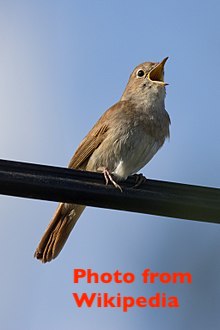
Luscinia megarhynchos - common nightingale in Wikipedia. Source: WIKIPEDIA
Luscinia_megarhynchos - common nightingale in Wikipedia.jpg
First observed in 🇨🇭 on 2020-04-19.
General: ![]() The common nightingale, rufous nightingale or simply nightingale (Luscinia megarhynchos), is a small passerine bird best known for its powerful and beautiful song. It was formerly classed as a member of the thrush family Turdidae, but is now more generally considered to be an Old World flycatcher, Muscicapidae.[2] It belongs to a group of more terrestrial species, often called chats.
[more]
The common nightingale, rufous nightingale or simply nightingale (Luscinia megarhynchos), is a small passerine bird best known for its powerful and beautiful song. It was formerly classed as a member of the thrush family Turdidae, but is now more generally considered to be an Old World flycatcher, Muscicapidae.[2] It belongs to a group of more terrestrial species, often called chats.
[more]
Vocalization: ![]() It consists of extremely resonant, full-bodied notes and lacks the, dry, rolling, rattling sounds of T.N. Most distinct species specific sound is the interwoven series of slightly ascending, plaintive notes (0.04 - 0.10 in recording). May mimic Thrush Nightningale!. [Link]
It consists of extremely resonant, full-bodied notes and lacks the, dry, rolling, rattling sounds of T.N. Most distinct species specific sound is the interwoven series of slightly ascending, plaintive notes (0.04 - 0.10 in recording). May mimic Thrush Nightningale!. [Link]
Song: ![]() The song is the best characteristic to separate it from T. Nightingale. [Link]
The song is the best characteristic to separate it from T. Nightingale. [Link]
Calls: ![]() Alarm call either a thin, flycatcher-like "weeet", or a Chiff-chaff-like "piuu". Also a characteristic (but similar to Thrush Nighitingale) dry, rattling, frog-like "rrrrr". [Link]
Alarm call either a thin, flycatcher-like "weeet", or a Chiff-chaff-like "piuu". Also a characteristic (but similar to Thrush Nighitingale) dry, rattling, frog-like "rrrrr". [Link]
Physical details: length=16 cm,
wingspan=23-26 cm,
weight=17-24 g
Habitats:
Wetland
Song:
Can be a sequence of unrelated weird but musical sounds - trills, churrs, human-like whistles - very amusing.
Song attributes:
Melody: improvised melodic, slow, Frequency: medium (1-5 KHz) Special sounds: whoop, weird, trill Singing season: 04-15 - 06-30
♫ Source: XENOCANTO
XC505897 - Common Nightingale - Luscinia megarhynchos - song, recorded in Spain.mp3
Spain (song)

Spotted flycatcher / Grauschnäpper (Muscicapa striata)
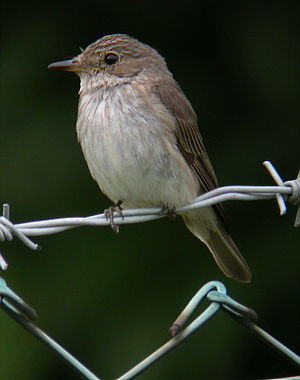
In a pinch barbed wire will do instead of a tree branch. Source: WIKIPEDIA
Wikipedia-300px-SpottedFlycatcheronfence.jpg
First observed in 🇨🇭 on 2020-06-03.
Perches on limbs in forest to swoop for insects and return to perch, specifically heard in woods near Staldenweiher.
Heard in woods near Staldenweiher, seen at Kaltbrunnerriet.
Has streaks on crown and breast, rather than spots.
Medium brown on head and back, light colored belly.
'Pincette-shaped beak'.
Gesang 'unauffaellig' - zirp x 2-3, mal steigender tWIT
Song: ![]() Song a primitive, slow series of various buzzing and very high pitched sounds. No recurring phrases. [Link]
Song a primitive, slow series of various buzzing and very high pitched sounds. No recurring phrases. [Link]
Calls: ![]() The discreet calls often goes unnoticed. Most calls high pitched with a buzzing, "electric" timbre. Alarm call a sharp, drawn "tzreeeee-check", with the second syllable abruptly clipping the sound. [Link]
The discreet calls often goes unnoticed. Most calls high pitched with a buzzing, "electric" timbre. Alarm call a sharp, drawn "tzreeeee-check", with the second syllable abruptly clipping the sound. [Link]
Physical details: length=14 cm,
wingspan=23-25 cm,
weight=14-20 g
Habitats:
Settlement
Song:
High (6-8 KHz?) short sound repeated every half to 5 seconds.
Song attributes:
Melody: simple rhythmic, slow, Frequency: 6-8 KHz
Call:
General: To me something between a one-note and an extremely simple melody, namely med-med chk-hi-med-med, with a very irregular speed, not at all like a metronome.
Call: ![]() Most calls high pitched with a buzzing, "electric" timbre. [Link]
Most calls high pitched with a buzzing, "electric" timbre. [Link]
XC656714 - Spotted Flycatcher - Muscicapa striata - Sounds similar to what I know.
♫ XC656714 - Spotted Flycatcher - Muscicapa striata - Sounds similar to what I know. Source: XENOCANTO
XC656714 - Spotted Flycatcher - Muscicapa striata.mp3
(call)
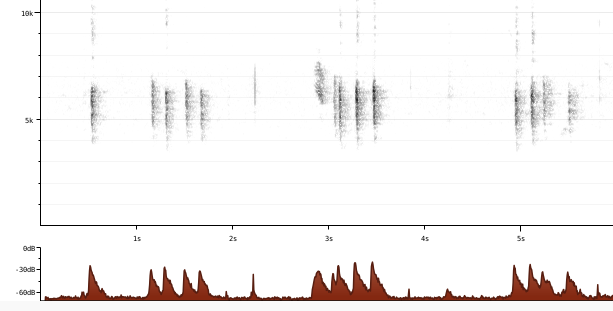
Call attributes:
Call melody: stereotype melodic, slow, Frequency: 4-7 KHz,
Stonechat / Schwarzkehlchen (Saxicola rubicola)
Schwarzkehlchen, Neunkirch. 2023-07-16 10.52.36 Neunkirch, Schaffhausen
First observed in 🇨🇭 on 2021-04-27.
Etymology: Nabu: Der wissenschaftlich Name „rubicola“ bedeutet „Brombeerstrauch-Bewohner“. Einzelne Sträucher auf einer sonst offenen Fläche fliegt das Schwarzkehlchen gerne an.
[Link]
![]() They breed in heathland, coastal dunes and rough grassland with scattered small shrubs and bramble, open gorse, tussocks or heather. [Link]
They breed in heathland, coastal dunes and rough grassland with scattered small shrubs and bramble, open gorse, tussocks or heather. [Link]
Song: ![]() The English name derives from its call, sounding like two stones knocked together. [Link]
The English name derives from its call, sounding like two stones knocked together. [Link]
![]() Gesang ähnlich obiger Art [Braunkehlchen]. Reine und kratzende Laute abwechselnd, wellenförmig
[Link]
Gesang ähnlich obiger Art [Braunkehlchen]. Reine und kratzende Laute abwechselnd, wellenförmig
[Link]
![]() The song is a sweet stream of scratchy notes. Much more even, and less chattering than the Whinchat. Almost like a short and scratchy Dunnock phrase. [Link]
The song is a sweet stream of scratchy notes. Much more even, and less chattering than the Whinchat. Almost like a short and scratchy Dunnock phrase. [Link]
Calls: ![]() hart „track“ oder „fiet-track-track“
[Link]
hart „track“ oder „fiet-track-track“
[Link]
![]() Alarm call an alternation of a high-pitched "weet" and a hard "check", like other chats. The "weet" is much higher pitched than the similar call of Whinchat, and Stonechat repeats the "check" more frequently. [Link]
Alarm call an alternation of a high-pitched "weet" and a hard "check", like other chats. The "weet" is much higher pitched than the similar call of Whinchat, and Stonechat repeats the "check" more frequently. [Link]
Physical details: length=12 cm,
wingspan=18-21 cm,
weight=13-17 g
Habitats:
Agricultural
Song:
General: Series of short, often squawky little bits, sometimes like a house sparrow, often repeated with only small variation. E.g. MmLMH?
Song: ![]() Kurzer Gesang, eher steigend 8-19 slurred notes. Or 21 43 2143 [Link]
Kurzer Gesang, eher steigend 8-19 slurred notes. Or 21 43 2143 [Link]
Song attributes:
Melody: improvised melodic, fast, Frequency: 2-7 KHz
♫ Source: XENOCANTO
XC710467 - European Stonechat - Saxicola rubicola rubicola.mp3
(song)
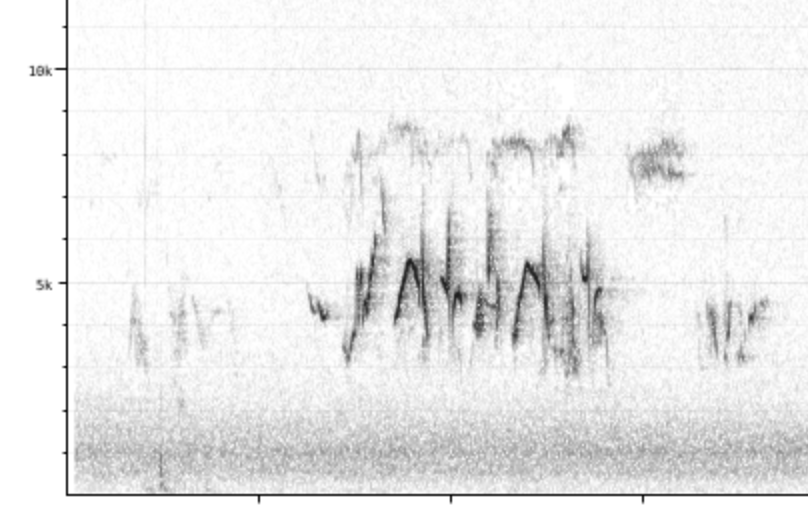
♫ Source: XENOCANTO
XC633658 - European Stonechat - Saxicola rubicola - song.mp3
(song)

Black redstart / Hausrotschwanz (Phoenicurus ochruros)
Profile Wikipedia eBird Vogelwarte BirdLife ZH ornitho.ch bird-song.ch Xeno-Canto BirdID NABU
Black redstart singing atop a tree This black redstart was singing in the tree by the tennis club behind the train station in Fehraltorf in April 2020 2020-04-23 11.17.18 Fehraltorf
First observed in 🇨🇭 on 2020-04-09.
Look for them in a treetop or the peak of a roof - they like to be heard and don't mind being seen.
Etymology: ![]() The English name Redstart intrigued me. According to Wikipedia, it comes from Middle English stert
meaning tail, so it's a redtail, which makes sense. As to black, they often look rather gray to me. [Link]
The English name Redstart intrigued me. According to Wikipedia, it comes from Middle English stert
meaning tail, so it's a redtail, which makes sense. As to black, they often look rather gray to me. [Link]
Vocalization: ![]() Next part is rather unique, and sounds as if shaking a handful of gravel. The phrase then usually closes with a couple of trills. [Link]
Next part is rather unique, and sounds as if shaking a handful of gravel. The phrase then usually closes with a couple of trills. [Link]
Song: Other: Einige Arten wie der Hausrotschwanz singen zudem im Herbst, bevor sie in ihr Winterquartier ziehen. Die Männchen legen dann ihre Reviere bereits «provisorisch» fest. [Link]
![]() Am Morgen der erste Sänger: Kurzes dreiteiliges Liedchen, meist von Warte aus gesungen. Mittelstück aus rauen gequetschten Tönen. (als ob kurz die Stimme verloren)
[Link]
Am Morgen der erste Sänger: Kurzes dreiteiliges Liedchen, meist von Warte aus gesungen. Mittelstück aus rauen gequetschten Tönen. (als ob kurz die Stimme verloren)
[Link]
![]() Song consists of three parts and is distinct if heard well. It opens with some clear notes that may form a trill, which are then followed by a pause. The "gravel-part" does not carry as far as the rest of the song. [Link]
Song consists of three parts and is distinct if heard well. It opens with some clear notes that may form a trill, which are then followed by a pause. The "gravel-part" does not carry as far as the rest of the song. [Link]
Calls: ![]() „hüid-tze“ das tze deutlich tiefer.
[Link]
„hüid-tze“ das tze deutlich tiefer.
[Link]
![]() Alarm call is a chat-like alternation between short, high-pitched "wit" sounds, and series of hard and dry "teck". [Link]
Alarm call is a chat-like alternation between short, high-pitched "wit" sounds, and series of hard and dry "teck". [Link]
Physical details: length=14 cm,
wingspan=23-26 cm,
weight=13-19 g
Habitats:
Settlement
Song:
The song is two parts and unvarying. If it were a pop song, you'd call it ABABAB... The second part starts with a
sputtering trill. The RSPB in the UK says 'warble with crackling trills.' Vogelwarte.ch says
'Der gepresst knirschende Gesang setzt meist lange vor Sonnenaufgang ein und ist der Auftakt für das Vogelkonzert.'
BirdLife-Zuerich.ch says 'Einziger Sänger morgens um drei in den Häuserschluchten'.
Obwohl NABU.de meint, sie singen nicht mehr nach Juli, war ich angenehm überrascht sie in Oktober im Tessin zu hören.
Song attributes:
Melody: stereotype melodic, slow, Frequency: high (3-9 KHz) Special sounds: churr Singing season: 03-01 - 07-31 Dawn chorus start, 70 minutes before dawn.
Calls:
1:
XC560014 matches exactly what BirdID describes: 'Alarm call is a chat-like alternation between short, high-pitched "wit" sounds, and series of hard and dry "teck".' The high-pitched call I heard recently was between 5 and 6 KHz, which could help to distinguish between other birds with a deeper voice. The whooping call is sometimes listed as an alarm call.
♫ Source: XENOCANTO
XC657510 - Black Redstart - Phoenicurus ochruros - call.mp3
(call)

♫ Very high notes. Source: XENOCANTO
XC560014 black redstart call.mp3
(call)

2:
Begging call sputters
♫ Source: XENOCANTO
XC567747-Black Redstart begging call.mp3
(begging call)
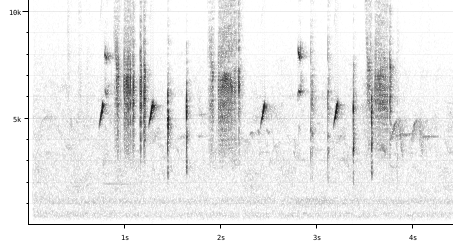
Call attributes:
Call melody: one note, slow, Frequency: 4-5 KHz, Special sounds: sputter/pebble-clatter, whoop.
Australian brown flycatcher (Microeca fascinans)
Ein gruppe evtl junge Hausrotchwanz im Feld gegenueber von Pferderennbahn - normalerweise sind sie nur sozial im Winter aber vielleicht sind sie gerade von den Eltern weggezogen? 2024-05-13 07.06.57 Fehraltorf
Profile Wikipedia eBird Vogelwarte BirdLife ZH ornitho.ch Xeno-Canto BirdID NABU

Wikipedia: Woodchat shrike Source: OTHER
1200px-Woodchat_shrike_%28Lanius_senator_senator%29.jpg
General: ![]() The woodchat shrike (Lanius senator) is a member of the shrike family Laniidae. It can be identified by its red-brown crown and nape. It is mainly insectivorous and favours open wooded areas with scattered trees such as orchards, particularly when there is bare or sandy ground. The woodchat shrike breeds in southern Europe, the Middle East and northwest Africa, and winters in tropical Africa.
[more]
The woodchat shrike (Lanius senator) is a member of the shrike family Laniidae. It can be identified by its red-brown crown and nape. It is mainly insectivorous and favours open wooded areas with scattered trees such as orchards, particularly when there is bare or sandy ground. The woodchat shrike breeds in southern Europe, the Middle East and northwest Africa, and winters in tropical Africa.
[more]
Song: ![]() Territorial song loud and varied. Often repeats phrases and includes mimicry. Alternativ song a more continuous chattering with impressive mimicry similar to Red-backed and Lesser Grey Shrike, and difficult to separate from those. [Link]
Territorial song loud and varied. Often repeats phrases and includes mimicry. Alternativ song a more continuous chattering with impressive mimicry similar to Red-backed and Lesser Grey Shrike, and difficult to separate from those. [Link]
Calls: ![]() Alarm call a dry, magpie-like "che-che-che-che-che", or a nasal, ascending oriole-like "weea". [Link]
Alarm call a dry, magpie-like "che-che-che-che-che", or a nasal, ascending oriole-like "weea". [Link]
Physical details: length=18 cm,
wingspan=26-28 cm,
weight=30-40 g
Habitats:
Agricultural
Song:
![]() Territorial song loud and varied. Often repeats phrases and includes mimicry. Alternative [non-territorial] song a more continuous chattering with impressive mimicry similar to Red-backed and Lesser Grey Shrike, and difficult to separate from those. [Link]
Territorial song loud and varied. Often repeats phrases and includes mimicry. Alternative [non-territorial] song a more continuous chattering with impressive mimicry similar to Red-backed and Lesser Grey Shrike, and difficult to separate from those. [Link]
Song attributes:
Melody: sings 30 seconds or longer, fast, Frequency: 2-6 KHz Special sounds: mimicry
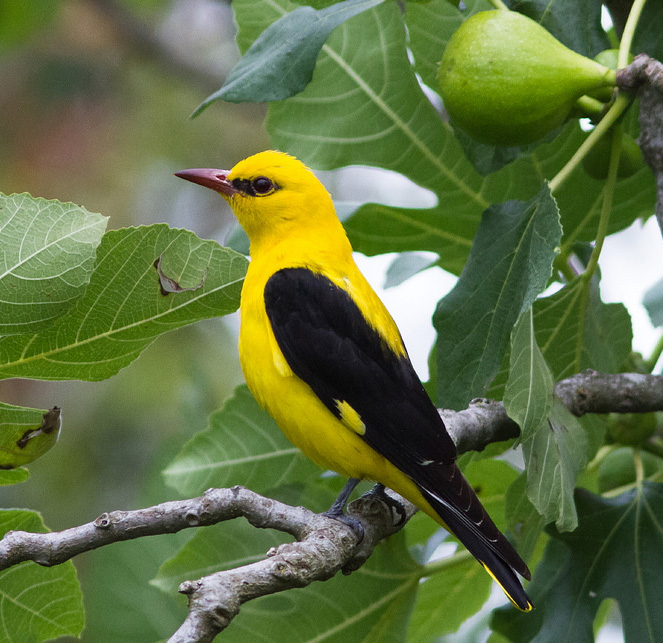
Wikimedia Eurasian golden oriole. Source: WIKIPEDIA
Wikimedia Eurasian golden oriole.jpg
First observed in 🇨🇭 on 2020-05-25.
Pirol: auffälligen Sexualdimorphismus.
Wo/Habitat: lichter Auenwälder, Bruchwälder und gewässernaher Gehölze. Ebenso zählen Laub-, Misch- und Nadelwälder sowie Parks, große Gärten, Friedhöfe, Streuobstwiesen, hohe Obstbäume, Windschutzgürtel und Alleen zu seinen Brutgebieten, wo er sich überwiegend im Kronendach höherer Bäume aufhält.
Der Verbreitungsschwerpunkt liegt hier im kontinentaleren Osteuropa.
knapp amselgross;
Presence april 15 - September 15
https://www.vogelwarte.ch/de/voegel/voegel-der-schweiz/pirol
In Western Europe they prefer open broadleaf forests and plantations, copses, riverine forest, orchards, large gardens.They reside in Switzerland from mid-April to mid-September, breeding in mid-May to mid-July.
They predominate near the German and French borders, from Lake Constance to Geneva.
I want to try to see one at Neeracherried or Thurauen.
Geography: ![]() Wikipedia: only member of the oriole family of passerine birds breeding in Northern Hemisphere temperate regions. It is a summer migrant in Europe and western Asia and spends the winter season in central and southern Africa. [Link]
Wikipedia: only member of the oriole family of passerine birds breeding in Northern Hemisphere temperate regions. It is a summer migrant in Europe and western Asia and spends the winter season in central and southern Africa. [Link]
Song: ![]() Varied repertoire, but song and common contact call very distinct. Song a series of 1-2 seconds long phrases of 3-5 yodeling, clear, fluting notes, interspersed with 2-3 second pauses. Tone very full-bodied, melodic and pleasing. [Link]
Varied repertoire, but song and common contact call very distinct. Song a series of 1-2 seconds long phrases of 3-5 yodeling, clear, fluting notes, interspersed with 2-3 second pauses. Tone very full-bodied, melodic and pleasing. [Link]
Calls: ![]() Flötenrufen
Oft wird der Gesang allerdings vom Star treffend ähnlich nachgeahmt. [Link]
Flötenrufen
Oft wird der Gesang allerdings vom Star treffend ähnlich nachgeahmt. [Link]
![]() Contact call surprisingly different: A forced, drawn "weeackt", slightly resembling Jay, but less harsh, and much more nasal. Other sounds include a Wryneck-like warning call. [Link]
Contact call surprisingly different: A forced, drawn "weeackt", slightly resembling Jay, but less harsh, and much more nasal. Other sounds include a Wryneck-like warning call. [Link]
Physical details: length=24 cm,
wingspan=44-47 cm,
weight=56-79 g
Habitats:
Forest
Song:
A soft, lowish whistling. In my opinion, the golden oriole has a beautiful voice, but no imagination as to melody - it's always the same few notes.
Song attributes:
Melody: stereotype melodic, slow, Frequency: 0-1 KHz Singing season: 04-22 - 09-21
♫ Source: XENOCANTO
XC567973 eurasian golden oriole song.mp3
(song)

Call:
3 somewhat harsh ascending notes, more melodic than a Eurasian jay call
♫ Source: XENOCANTO
XC565722 eurasian golden oriole call.mp3
(call)

Call attributes:
Call melody: simple rhythmic, slow, Frequency: medium (1-5 KHz),
Presence: 04-15 - 09-15
Breeding: 03-15 - 07-15
Migration in: 04-15 - 06-10
Migration out: 07-10 - 09-15
Audouin's gull (alternate) (Ichthyaetus audouinii)
Audouin's gull in Portocolom, Mallorca. 2022-04-07 16.43.56 Mallorca
First observed in Mallorca on 2022-04-07.
Kentish plover / Seeregenpfeifer (Charadrius alexandrinus)
Profile Wikipedia eBird Vogelwarte BirdLife ZH ornitho.ch Audubon AllAboutBirds Xeno-Canto BirdID NABU
Der kleinste Watvoegel bei Ses Salines, Mallorcal, ein Seeregenpfeifer. 2022-04-08 17.00.16 Mallorca
First observed in Mallorca on 2022-04-08.
This bird appears across the great seas in the following continents:
Europe, North America, Africa, Asia, Australia.
vagrant
Song: ![]() Contact calls more frequently heard than song, with two distinct calls. A short and soft ascending whistle resembling chiff-chaff is often heard from the ground, and a hard and rolling "prrrrt" if flushed (or just a short "tip"). Song a hard and rolling sequence resembling Dunlin song, but less nasal and more pulsating. [Link]
Contact calls more frequently heard than song, with two distinct calls. A short and soft ascending whistle resembling chiff-chaff is often heard from the ground, and a hard and rolling "prrrrt" if flushed (or just a short "tip"). Song a hard and rolling sequence resembling Dunlin song, but less nasal and more pulsating. [Link]
Physical details: length=15-17 cm,
wingspan=42-45 cm,
weight=39-56 g
Habitats:
Wetland
Purple gallinule / Zwergsultanshuhn (Porphyrio martinica)
This bird appears across the great seas in the following continents:
North America, South America, Africa.
General: ![]() Das Zwergsultanshuhn (Porphyrio martinicus, Syn.: Porphyrula martinica) ist ein vor allem in Amerika heimischer Rallenvogel.
[more]
Das Zwergsultanshuhn (Porphyrio martinicus, Syn.: Porphyrula martinica) ist ein vor allem in Amerika heimischer Rallenvogel.
[more]
First observed in Yucatan on 2023-04-14.
![]() The black vulture (Coragyps atratus), also known as the American black vulture, is a bird in the New World vulture family whose range extends from the northeastern United States to Peru, Central Chile and Uruguay in South America. Although a common and widespread species, it has a somewhat more restricted distribution than its compatriot, the turkey vulture, which breeds well into Canada and south to Tierra del Fuego. It is the only extant member of the genus Coragyps, which is in the family Cathartidae. Despite the similar name and appearance, this species is unrelated to the Eurasian black vulture, an Old World vulture in the family Accipitridae (which includes eagles, hawks, kites, and harriers). It inhabits relatively open areas which provide scattered forests or shrublands. With a wingspan of 1.5 m (4.9 ft), the black vulture is a large bird though relatively small for a vulture. It has black plumage, a featherless, grayish-black head and neck, and a short, hooked beak.
[more]
The black vulture (Coragyps atratus), also known as the American black vulture, is a bird in the New World vulture family whose range extends from the northeastern United States to Peru, Central Chile and Uruguay in South America. Although a common and widespread species, it has a somewhat more restricted distribution than its compatriot, the turkey vulture, which breeds well into Canada and south to Tierra del Fuego. It is the only extant member of the genus Coragyps, which is in the family Cathartidae. Despite the similar name and appearance, this species is unrelated to the Eurasian black vulture, an Old World vulture in the family Accipitridae (which includes eagles, hawks, kites, and harriers). It inhabits relatively open areas which provide scattered forests or shrublands. With a wingspan of 1.5 m (4.9 ft), the black vulture is a large bird though relatively small for a vulture. It has black plumage, a featherless, grayish-black head and neck, and a short, hooked beak.
[more]

Wikipedia: Bonelli's eagle Source: OTHER
Bonelli%27s_Eagle_-_Montsonis_-_Spain_S4E8373_%2824849913309%29.jpg
![]() The Bonelli's eagle (Aquila fasciata) is a large bird of prey. The common name of the bird commemorates the Italian ornithologist and collector Franco Andrea Bonelli. Bonelli is credited with gathering the type specimen, most likely from an exploration of Sardinia.[3][4] Some antiquated texts also refer to this species as the crestless hawk-eagle.[5] Like all eagles, Bonelli's eagle belongs to the family Accipitridae. Its feathered legs marked it as member of the Aquilinae or booted eagle subfamily.[6] This species breeds from Southern Europe, Africa on the montane perimeter of the Sahara Desert and across the Indian Subcontinent to Indonesia. On Eurasia, this species may be found as far west as Portugal and as far east as southeastern China and Thailand. It is usually a resident breeder.[1][6] The Bonelli's eagle is often found in hilly or mountainous habitats, with rocky walls or crags, from sea level to 1,500 m (4,900 ft). Habitats are often open to wooded land and can occur in arid to semi-moist climate.[1] This eagle, though it can be considered partially opportunistic, is something of a special predator of certain birds and mammals, especially rabbits, galliforms and pigeons.[7] On evidence, when staple prey populations decline or are locally scarce, Bonelli's eagle switch to being an opportunistic predator of a wide variety of birds.[8] Despite its persistence over a large range and its continued classification as a least concern species by the IUCN, the Bonelli's eagle has declined precipitously in various parts of its range, including almost all of its European distribution, and may face potential local extinction. The species' declines are due to widespread habitat destruction, electrocution from electricity pylons as well as persistent persecution.[9][10]
[more]
The Bonelli's eagle (Aquila fasciata) is a large bird of prey. The common name of the bird commemorates the Italian ornithologist and collector Franco Andrea Bonelli. Bonelli is credited with gathering the type specimen, most likely from an exploration of Sardinia.[3][4] Some antiquated texts also refer to this species as the crestless hawk-eagle.[5] Like all eagles, Bonelli's eagle belongs to the family Accipitridae. Its feathered legs marked it as member of the Aquilinae or booted eagle subfamily.[6] This species breeds from Southern Europe, Africa on the montane perimeter of the Sahara Desert and across the Indian Subcontinent to Indonesia. On Eurasia, this species may be found as far west as Portugal and as far east as southeastern China and Thailand. It is usually a resident breeder.[1][6] The Bonelli's eagle is often found in hilly or mountainous habitats, with rocky walls or crags, from sea level to 1,500 m (4,900 ft). Habitats are often open to wooded land and can occur in arid to semi-moist climate.[1] This eagle, though it can be considered partially opportunistic, is something of a special predator of certain birds and mammals, especially rabbits, galliforms and pigeons.[7] On evidence, when staple prey populations decline or are locally scarce, Bonelli's eagle switch to being an opportunistic predator of a wide variety of birds.[8] Despite its persistence over a large range and its continued classification as a least concern species by the IUCN, the Bonelli's eagle has declined precipitously in various parts of its range, including almost all of its European distribution, and may face potential local extinction. The species' declines are due to widespread habitat destruction, electrocution from electricity pylons as well as persistent persecution.[9][10]
[more]

Wikipedia: Griffon vulture Source: OTHER
1200px-Gypful.jpg
![]() The griffon vulture (Gyps fulvus) is a large Old World vulture in the bird of prey family Accipitridae. It is also known as the Eurasian griffon. It is not to be confused with a different species, Rüppell's griffon vulture (Gyps rueppellii). It is closely related to the white-backed vulture (Gyps africanus).
[more]
The griffon vulture (Gyps fulvus) is a large Old World vulture in the bird of prey family Accipitridae. It is also known as the Eurasian griffon. It is not to be confused with a different species, Rüppell's griffon vulture (Gyps rueppellii). It is closely related to the white-backed vulture (Gyps africanus).
[more]
Vocalization: ![]() Quite vocal for a vulture, but generally silent in flight. Various shrieking high notes, hissing, and harsh cackling sounds. [Link]
Quite vocal for a vulture, but generally silent in flight. Various shrieking high notes, hissing, and harsh cackling sounds. [Link]
Physical details: length=95-105 cm,
wingspan=240-280 cm,
weight=7500-11000 g
Habitats:
Agricultural
Profile Wikipedia eBird Xeno-Canto
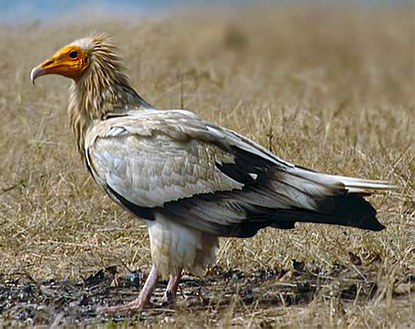
Wikipedia: Egyptian vulture Source: OTHER
Egyptian_vulture.jpg
General: ![]() The Egyptian vulture (Neophron percnopterus), also called the white scavenger vulture or pharaoh's chicken, is a small Old World vulture and the only member of the genus Neophron. It is widely distributed from the Iberian Peninsula and North Africa to India. The contrasting underwing pattern and wedge-shaped tail make it distinctive in flight as it soars in thermals during the warmer parts of the day. Egyptian vultures feed mainly on carrion but are opportunistic and will prey on small mammals, birds, and reptiles. They also feed on the eggs of other birds, breaking larger ones by tossing a large pebble onto them.
[more]
The Egyptian vulture (Neophron percnopterus), also called the white scavenger vulture or pharaoh's chicken, is a small Old World vulture and the only member of the genus Neophron. It is widely distributed from the Iberian Peninsula and North Africa to India. The contrasting underwing pattern and wedge-shaped tail make it distinctive in flight as it soars in thermals during the warmer parts of the day. Egyptian vultures feed mainly on carrion but are opportunistic and will prey on small mammals, birds, and reptiles. They also feed on the eggs of other birds, breaking larger ones by tossing a large pebble onto them.
[more]
Vocalization: ![]() Almost never heard. May emit different grunting sounds and a slightly mallard-like "ga ga ga ga ga ga ga". [Link]
Almost never heard. May emit different grunting sounds and a slightly mallard-like "ga ga ga ga ga ga ga". [Link]
Physical details: length=60-70 cm,
wingspan=155-180 cm,
weight=1600-2200 g
Profile Wikipedia eBird Vogelwarte BirdLife ZH ornitho.ch bird-song.ch Xeno-Canto BirdID NABU
Im Baum am Pfäffikersee 2020-05-20 08.58.48 Pfäffikersee
First observed in 🇨🇭 on 2020-04-13.
Geography: ![]() Very common here in the summer, I've seen up to 30 on a freshly plowed field, and you can seldom look up without seeing one.
(You should look closely though, as they'll often circle in the air with buzzards.)They migrate to Spain in the winter, but increasing numbers stay here.Elsewhere in Europe they've been decreasing, while here they've become so successful that young birds have trouble
finding a territory of their own. Wikipedia mentions them competing with the black kite, which I've never
identified locally, so perhaps that's part of the key to their success. [Link]
Very common here in the summer, I've seen up to 30 on a freshly plowed field, and you can seldom look up without seeing one.
(You should look closely though, as they'll often circle in the air with buzzards.)They migrate to Spain in the winter, but increasing numbers stay here.Elsewhere in Europe they've been decreasing, while here they've become so successful that young birds have trouble
finding a territory of their own. Wikipedia mentions them competing with the black kite, which I've never
identified locally, so perhaps that's part of the key to their success. [Link]
Vocalization: ![]() Mainly heard in breeding season. A piercing long whistle, quickly ascending, then descending "piuuu". Often used in movies to give an eerie wildlife mood. [Link]
Mainly heard in breeding season. A piercing long whistle, quickly ascending, then descending "piuuu". Often used in movies to give an eerie wildlife mood. [Link]
Calls: ![]() Differs from Black Kite in being a clear whistle all the way through the call, without "shivering". Higher pitched than Buzzard, and with less pause between calls. [Link]
Differs from Black Kite in being a clear whistle all the way through the call, without "shivering". Higher pitched than Buzzard, and with less pause between calls. [Link]
Physical details: length=60-66 cm,
wingspan=175-195 cm,
weight=800-1300 g
Habitats:
Agricultural
Song:
Automatically generated from Xeno-Canto recording
Song attributes:
Frequency:
♫ Rotmilan. 2020-05-24 16.56.51 Luppmen (song)
Call:
Automatically generated from Xeno-Canto recording
♫ Check if red kite begging calls. 2021-08-14 10.02.45 (begging call)
Call attributes:
begging call Frequency: ,
Presence: 01-01 - 12-31
Breeding: 04-10 - 07-28
Migration in: 01-20 - 04-30
Migration out: 08-18 - 11-28
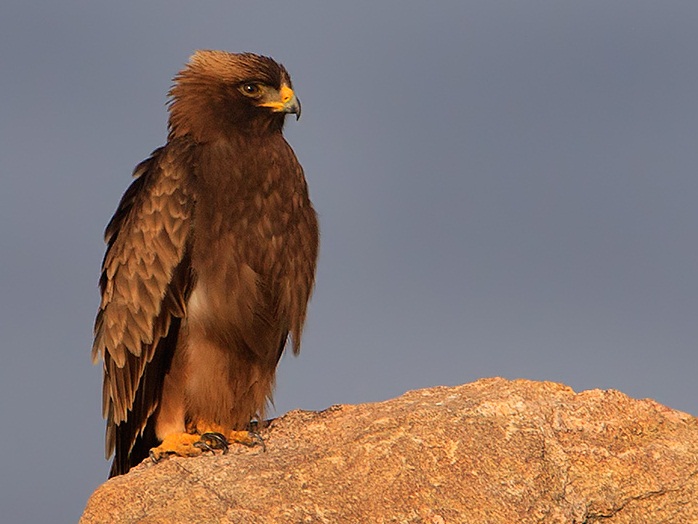
Wikipedia: Booted eagle Source: OTHER
MH_Booted.jpg
General: ![]() The booted eagle (Hieraaetus pennatus, also classified as Aquila pennata) is a medium-sized mostly migratory bird of prey with a wide distribution in the Palearctic and southern Asia, wintering in the tropics of Africa and Asia, with a small, disjunct breeding population in south-western Africa. Like all eagles, it belongs to the family Accipitridae.
[more]
The booted eagle (Hieraaetus pennatus, also classified as Aquila pennata) is a medium-sized mostly migratory bird of prey with a wide distribution in the Palearctic and southern Asia, wintering in the tropics of Africa and Asia, with a small, disjunct breeding population in south-western Africa. Like all eagles, it belongs to the family Accipitridae.
[more]
Vocalization: ![]() Very vocal in breeding season. Most often heard is a quite soft, wader-like series of "kli-kli-kli-kli-kli-kli". [Link]
Very vocal in breeding season. Most often heard is a quite soft, wader-like series of "kli-kli-kli-kli-kli-kli". [Link]
Physical details: length=45-53 cm,
wingspan=100-121 cm,
weight=510-1250 g
Osprey / Fischadler (Pandion haliaetus)
Osprey in flight. 2023-09-27 12.22.08 Florida
First observed in Yucatan on 2023-04-21.
This bird appears across the great seas in the following continents:
Europe, North America, South America, Africa, Asia.
General: ![]() Falco haliaetus Linnaeus, 1758
[more]
Falco haliaetus Linnaeus, 1758
[more]
Calls: ![]() Calls with sequences of short, soft and clear whistling notes. Often in series with rising pitch, then ending with a few lower pitched notes. [Link]
Calls with sequences of short, soft and clear whistling notes. Often in series with rising pitch, then ending with a few lower pitched notes. [Link]
Physical details: length=55-58 cm,
wingspan=145-170 cm,
weight=1120-2050 g
Habitats:
Agricultural
Song:
Automatically generated from Xeno-Canto recording
Song attributes:
Frequency:
♫ 2023-10-12 15 55 surprising sound of an osprey. 2023-10-12 15.55.00 New England (song)
Stork in field towards Mesikon 2020-04-25 07.19.22 Luppmen
First observed in 🇨🇭 on 2020-04-25.
New as frequent visitor in Fehraltorf area in the 2010's. It actually died out in Switzerland in the 1950's, but has reestablished itself.
Either in the fields looking for food, or on a high output like a lamppost
(the soccer field has especially high ones) or the chimneys at the RAV/Electrosuisse building or occasinally
a rooftop.
Vocalization: ![]() Mostly silent. Loud, modulated bill-clattering from both sexes is heard during courtship/display. [Link]
Mostly silent. Loud, modulated bill-clattering from both sexes is heard during courtship/display. [Link]
Physical details: length=100-115 cm,
wingspan=155-165 cm,
weight=2275-4400 g
Habitats:
Wetland
Song:
The famous Klappern.
Song attributes:
Melody: non-musical, slow, Frequency: low (1-3 KHz) Special sounds: rattle
Bienenfresser. 2022-05-21 12.53.36 Leuk and surroundings
First observed in 🇨🇭 on 2022-05-21.
Hoped to hear it and especially see it in Maienfeld (Kulturland-Exkursion) but didn't. It'll show up in Leuk in 2022!
Habitats:
Agricultural
Song:
BirdID says multi-syllabic, rolling phrases, although it often seems to be one syllable as well. Hope to hear it and especially see it in Maienfeld.
Song attributes:
Melody: simple rhythmic, slow, Frequency: medium (1-5 KHz)
Profile Wikipedia eBird Xeno-Canto NABU
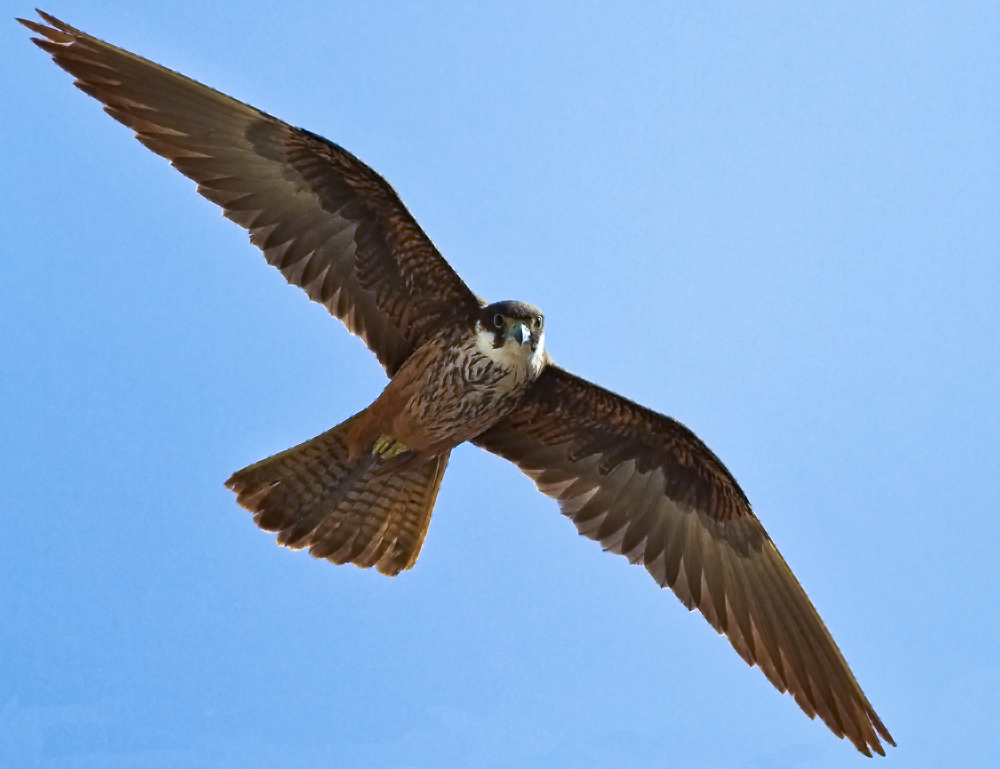
Wikipedia: Eleonora's falcon Source: OTHER
Eleonorenfalke1.jpg
General: ![]() Eleonora's falcon (Falco eleonorae) is a medium-sized falcon. It belongs to the hobby group, a rather close-knit number of similar falcons often considered a subgenus Hypotriorchis. The sooty falcon is sometimes considered its closest relative, but while they certainly belong to the same lineage, they do not seem to be close sister species.[2][3] The English name and the species name eleonorae commemorate Eleanor of Arborea, Queen or Lady-Judge (Juighissa) and national heroine of Sardinia, who in 1392, under the jurisdiction conferred by the Carta de Logu, became the first ruler in history to grant protection to hawk and falcon nests against illegal hunters.[4][5][6] The genus name falco is from Late Latin falx, falcis, a sickle, referring to the claws of the bird.[7]
[more]
Eleonora's falcon (Falco eleonorae) is a medium-sized falcon. It belongs to the hobby group, a rather close-knit number of similar falcons often considered a subgenus Hypotriorchis. The sooty falcon is sometimes considered its closest relative, but while they certainly belong to the same lineage, they do not seem to be close sister species.[2][3] The English name and the species name eleonorae commemorate Eleanor of Arborea, Queen or Lady-Judge (Juighissa) and national heroine of Sardinia, who in 1392, under the jurisdiction conferred by the Carta de Logu, became the first ruler in history to grant protection to hawk and falcon nests against illegal hunters.[4][5][6] The genus name falco is from Late Latin falx, falcis, a sickle, referring to the claws of the bird.[7]
[more]

Wikipedia: Peregrine falcon Source: OTHER
Falco_peregrinus_good_-_Christopher_Watson.jpg
This bird appears across the great seas in the following continents:
Europe, North America, South America, Africa, Asia.
![]() The peregrine falcon (Falco peregrinus), also known as the peregrine,[2] and historically as the duck hawk in North America,[3] is a widespread bird of prey (raptor) in the family Falconidae. A large, crow-sized falcon, it has a blue-grey back, barred white underparts, and a black head. The peregrine is renowned for its speed, reaching over 320 km/h (200 mph) during its characteristic hunting stoop (high-speed dive),[4] making it the fastest bird in the world, as well as the fastest member of the animal kingdom.[5][6][7] According to a National Geographic TV program, the highest measured speed of a peregrine falcon is 389 km/h (242 mph).[8][9] As is typical for bird-eating raptors, peregrine falcons are sexually dimorphic, with females being considerably larger than males.[10][11]
[more]
The peregrine falcon (Falco peregrinus), also known as the peregrine,[2] and historically as the duck hawk in North America,[3] is a widespread bird of prey (raptor) in the family Falconidae. A large, crow-sized falcon, it has a blue-grey back, barred white underparts, and a black head. The peregrine is renowned for its speed, reaching over 320 km/h (200 mph) during its characteristic hunting stoop (high-speed dive),[4] making it the fastest bird in the world, as well as the fastest member of the animal kingdom.[5][6][7] According to a National Geographic TV program, the highest measured speed of a peregrine falcon is 389 km/h (242 mph).[8][9] As is typical for bird-eating raptors, peregrine falcons are sexually dimorphic, with females being considerably larger than males.[10][11]
[more]
Vocalization: ![]() A harsh, drawn out "kiaaaa" with emphasised endings repeated in series. Much slower than Merlin, but higher pitched than Gyrfalcon. [Link]
A harsh, drawn out "kiaaaa" with emphasised endings repeated in series. Much slower than Merlin, but higher pitched than Gyrfalcon. [Link]
Calls: ![]() Also shorter, coarse warning-calls. [Link]
Also shorter, coarse warning-calls. [Link]
Physical details: length=36-48 cm,
wingspan=95-110 cm,
weight=582-1300 g
Habitats:
Agricultural

Bushman flamingo carving. 2016-09-09 17.16.22 Namibia
First observed in Namibia on 2016-09-09.
General: ![]() The greater flamingo (Phoenicopterus roseus) is the most widespread and largest species of the flamingo family. It is found in Africa, the Indian subcontinent, the Middle East, and in southern Europe.
[more]
The greater flamingo (Phoenicopterus roseus) is the most widespread and largest species of the flamingo family. It is found in Africa, the Indian subcontinent, the Middle East, and in southern Europe.
[more]
Vocalization: ![]() Nasal, di-syllabic, gooselike honking. Sometimes pure and high-pitched, other times deep and with peculiar, raspy, frog-like quality. [Link]
Nasal, di-syllabic, gooselike honking. Sometimes pure and high-pitched, other times deep and with peculiar, raspy, frog-like quality. [Link]
Physical details: length=125-145 cm,
wingspan=105-155 cm,
weight=3000-4100 g
Profile Wikipedia eBird Vogelwarte BirdLife ZH ornitho.ch bird-song.ch Xeno-Canto BirdID NABU
Wendehals in Susten. 2022-05-21 10.28.36 Leuk and surroundings
First observed in 🇨🇭 on 2021-05-10.
Invisible as soon as it lands in a tree - perfect bark camouflage.
Vocalization: ![]() Normally silent when not breeding. Other sounds: a guttural "gru", and hissing sounds when threatened. [Link]
Normally silent when not breeding. Other sounds: a guttural "gru", and hissing sounds when threatened. [Link]
Song: ![]() Reihe von 8-12 Pfeiftönen. Klingt fast etwas heiser., Jeder Ruf etwas absinkend. Die Tonhöhe kann innerhalb der Reihe etwas schwanken, etwas zunehmen und eindringlicher werden. Klangfarbe weich, obertönig.
[Link]
Reihe von 8-12 Pfeiftönen. Klingt fast etwas heiser., Jeder Ruf etwas absinkend. Die Tonhöhe kann innerhalb der Reihe etwas schwanken, etwas zunehmen und eindringlicher werden. Klangfarbe weich, obertönig.
[Link]
![]() Song (both sexes): an insisting, Merlin- or Lesser Spotted Woodpecker-like series of plaintive "kee kee kee kee kee ". First slightly ascending, then descending. [Link]
Song (both sexes): an insisting, Merlin- or Lesser Spotted Woodpecker-like series of plaintive "kee kee kee kee kee ". First slightly ascending, then descending. [Link]
Physical details: length=16-17 cm,
wingspan=25-27 cm,
weight=30-45 g
Habitats:
Agricultural
Song:
Woodpecker-like series of up to 25 slightly rising calls.
Song attributes:
Melody: non-musical, slow, Frequency: 1-6 KHz
Profile Wikipedia eBird Xeno-Canto NABU
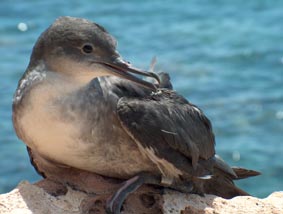
Wikipedia: Balearic shearwater Source: OTHER
Puffinus_mauretanicus.jpg
General: ![]() The Balearic shearwater (Puffinus mauretanicus) is a medium-sized shearwater in the seabird family Procellariidae. Puffinus is a New Latin loanword based on the English "puffin" and its variants, that referred to the cured carcass of the fat nestling of the Manx shearwater, a former delicacy.[2] The specific mauretanicus refers to Mauretania, an old name for an area of North Africa roughly corresponding to Morocco and Algeria.[3]
[more]
The Balearic shearwater (Puffinus mauretanicus) is a medium-sized shearwater in the seabird family Procellariidae. Puffinus is a New Latin loanword based on the English "puffin" and its variants, that referred to the cured carcass of the fat nestling of the Manx shearwater, a former delicacy.[2] The specific mauretanicus refers to Mauretania, an old name for an area of North Africa roughly corresponding to Morocco and Algeria.[3]
[more]

Wikipedia: Eurasian scops owl Source: OTHER
1200px-Scops_Owl_%28Otus_scops%29%2C_Kalloni%2C_Lesvos%2C_Greece%2C_19.04.2015_%2816773748434%29.jpg
![]() The Eurasian scops owl (Otus scops), also known as the European scops owl or just scops owl, is a small owl in the typical owl family Strigidae. Its breeding range extends from southern Europe eastwards to southern Siberia and the western Himalayas. It is migratory, wintering in Africa south of the Sahara.
[more]
The Eurasian scops owl (Otus scops), also known as the European scops owl or just scops owl, is a small owl in the typical owl family Strigidae. Its breeding range extends from southern Europe eastwards to southern Siberia and the western Himalayas. It is migratory, wintering in Africa south of the Sahara.
[more]
Song: ![]() Song: a slightly descending, short "klooit". The tone is resonant, clear and pure, unlike Little Owl. [Link]
Song: a slightly descending, short "klooit". The tone is resonant, clear and pure, unlike Little Owl. [Link]
Calls: ![]() Calls uttered endlessly in a frequency of about 20 a minute. Resembles Midwife Toad (Alytes), but is clearly modulated in pitch, as opposed to the toads straight tone. [Link]
Calls uttered endlessly in a frequency of about 20 a minute. Resembles Midwife Toad (Alytes), but is clearly modulated in pitch, as opposed to the toads straight tone. [Link]
Physical details: length=19-20 cm,
wingspan=53-63 cm,
weight=60-120 g
Habitats:
Agricultural

Wikipedia: Little owl Source: OTHER
1200px-Mochuelo_Com%C3%BAn_%28_Athene_noctua_%29%281%29.jpg
Behavior: ![]() Seltener Vogel brütet in der Nordwestschweiz. Nach 40 Jahren ist der Steinkauz zurück in der Nordwestschweiz.
Die seltenen Vögel haben wieder in der Region gebrütet, wie Bird Life meldet.
Über eine Million Franken haben die vier Nordwestschweizer Kantone und Partner dafür investiert. [Artikel im Tagi]
Seltener Vogel brütet in der Nordwestschweiz. Nach 40 Jahren ist der Steinkauz zurück in der Nordwestschweiz.
Die seltenen Vögel haben wieder in der Region gebrütet, wie Bird Life meldet.
Über eine Million Franken haben die vier Nordwestschweizer Kantone und Partner dafür investiert. [Artikel im Tagi]
Vocalization: ![]() Rich repertoire of social sounds: E.g. a clear "klewew", and sharp short "kek kek kek". [Link]
Rich repertoire of social sounds: E.g. a clear "klewew", and sharp short "kek kek kek". [Link]
Song: ![]() Song a clear drawn "klooit" resembling Scops Owl, but with different intonation and longer single notes. [Link]
Song a clear drawn "klooit" resembling Scops Owl, but with different intonation and longer single notes. [Link]
Calls: ![]() Tone rises slowly in pitch throughout the call and ends with marked raised pitch, often with a change in timbre to a coarse shriek. [Link]
Tone rises slowly in pitch throughout the call and ends with marked raised pitch, often with a change in timbre to a coarse shriek. [Link]
Physical details: length=21-23 cm,
wingspan=54-58 cm,
weight=140-220 g
Habitats:
Agricultural
Wiedehopf. 2022-05-22 11.02.06 Leuk and surroundings
First observed in Mallorca on 2022-04-07.
Song: ![]() 3 cooing Noten: wie de hopf, or hoop-hoop-hoop [Link]
3 cooing Noten: wie de hopf, or hoop-hoop-hoop [Link]
![]() Song a characteristic, hollow, far-reaching and trisyllabic "hoop-hoop-hoop". Dove-like timbre and slightly ascending in pitch. Sometimes two or four syllables, depending on virility of male. [Link]
Song a characteristic, hollow, far-reaching and trisyllabic "hoop-hoop-hoop". Dove-like timbre and slightly ascending in pitch. Sometimes two or four syllables, depending on virility of male. [Link]
Calls: ![]() Other calls include a dry, hoarse and rasping "ehrrrrrr". [Link]
Other calls include a dry, hoarse and rasping "ehrrrrrr". [Link]
Physical details: length=26-28 cm,
wingspan=42-46 cm,
weight=55-87 g
Habitats:
Agricultural
Probably a cormorant, as these have a light belly when immature and have no yellow on the bill like the shag. 2022-04-12 14.28.50 Mallorca
First observed in Mallorca on 2022-04-12.
General: ![]() The common scimitarbill (Rhinopomastus cyanomelas) is a species of bird in the family Phoeniculidae.
It is found in Angola, Botswana, Burundi, Democratic Republic of the Congo, Kenya, Malawi, Mozambique, Namibia, Rwanda, Somalia, South Africa, Swaziland, Tanzania, Uganda, Zambia, and Zimbabwe.
[more]
The common scimitarbill (Rhinopomastus cyanomelas) is a species of bird in the family Phoeniculidae.
It is found in Angola, Botswana, Burundi, Democratic Republic of the Congo, Kenya, Malawi, Mozambique, Namibia, Rwanda, Somalia, South Africa, Swaziland, Tanzania, Uganda, Zambia, and Zimbabwe.
[more]
Song:
Automatically generated from Xeno-Canto recording
Song attributes:
Frequency:
♫ Bill laeuft Richtung Singdrossel bei der Waldhuette in Fehraltorf. ![]() Source: Zoom H6 2023-02-22 17.02.58 Forsthaus (song)
Source: Zoom H6 2023-02-22 17.02.58 Forsthaus (song)

Wikipedia: Pallid swift Source: OTHER
Apus_pallidus_-Greece-8.jpg
![]() The pallid swift (Apus pallidus) is a small bird, superficially similar to a barn swallow or house martin. It is, however, completely unrelated to those passerine species, since the swifts are in the order Apodiformes. The resemblances between the groups are due to convergent evolution reflecting similar life styles.
[more]
The pallid swift (Apus pallidus) is a small bird, superficially similar to a barn swallow or house martin. It is, however, completely unrelated to those passerine species, since the swifts are in the order Apodiformes. The resemblances between the groups are due to convergent evolution reflecting similar life styles.
[more]
Vocalization: ![]() Similar to Common Swift, but usually very helpful for ID. Almost di-syllabic, with marked accent on second syllable which rapidly drops in pitch, "srrrree-aah". [Link]
Similar to Common Swift, but usually very helpful for ID. Almost di-syllabic, with marked accent on second syllable which rapidly drops in pitch, "srrrree-aah". [Link]
Calls: ![]() Common swift has a more even call, with accents on first part, without the sudden pitch-drop. [Link]
Common swift has a more even call, with accents on first part, without the sudden pitch-drop. [Link]
Physical details: length=16-17 cm,
wingspan=42-46 cm,
weight=41 g
Habitats:
Settlement

Wikipedia: Alpine swift Source: OTHER
1200px-%CE%92%CE%BF%CF%85%CE%BD%CE%BF%CF%83%CF%84%CE%B1%CF%87%CF%84%CE%AC%CF%81%CE%B1_Alpine_Swift_Tachymarptis_melba.jpg
First observed in 🇨🇭 on 2020-06-20.
General: ![]() The Alpine swift (Tachymarptis melba) formerly Apus melba, is a species of swift. The genus name is from the Ancient Greek takhus, "fast", and marptis, "seizer". The specific name melba comes from ‘melano-alba’ or ‘mel-alba’; Eigenhuis & Swaab (1992) posited that ‘melba’ might be a short form for ‘melano-alba’ or ‘mel-alba’ (Gr. melas, melanos = black; L. albus = white). Linnaeus certainly referred to these two colors in his diagnosis.[2]
[more]
The Alpine swift (Tachymarptis melba) formerly Apus melba, is a species of swift. The genus name is from the Ancient Greek takhus, "fast", and marptis, "seizer". The specific name melba comes from ‘melano-alba’ or ‘mel-alba’; Eigenhuis & Swaab (1992) posited that ‘melba’ might be a short form for ‘melano-alba’ or ‘mel-alba’ (Gr. melas, melanos = black; L. albus = white). Linnaeus certainly referred to these two colors in his diagnosis.[2]
[more]
Habitats:
Settlement
Song:
Automatically generated from Xeno-Canto recording
Song attributes:
Frequency:
♫ Source: BirdNet
20200620_121816 birdnet 688 - Alpine swift.mp3
2020-06-20 12.18.16 Luppmen (song)
Classification errors:
Eastern subalpine warbler / Weissbartgrasmücke (Sylvia cantillans)
![]() The eastern subalpine warbler (Curruca cantillans) is a small typical warbler which breeds in the southernmost areas of Europe. It was first described by the German naturalist Peter Simon Pallas in 1764 and given the binomial name Motacilla cantillans.[2][3][4] The specific cantillans is Latin for "warbling" from canere, "to sing".[5]
[more]
The eastern subalpine warbler (Curruca cantillans) is a small typical warbler which breeds in the southernmost areas of Europe. It was first described by the German naturalist Peter Simon Pallas in 1764 and given the binomial name Motacilla cantillans.[2][3][4] The specific cantillans is Latin for "warbling" from canere, "to sing".[5]
[more]
Song: ![]() Song a rapid, vivid stream of squeaks and clearer notes, with timbre similar to Whitethroat. [Link]
Song a rapid, vivid stream of squeaks and clearer notes, with timbre similar to Whitethroat. [Link]
Calls: ![]() Alarm call a short, hard "tuk", but softer and fainter than Blackcap and Sardinian W. May be confused with Sardinian W., but lacks that species interwoven hard and rolling contact call. [Link]
Alarm call a short, hard "tuk", but softer and fainter than Blackcap and Sardinian W. May be confused with Sardinian W., but lacks that species interwoven hard and rolling contact call. [Link]
Physical details: length=12 cm,
wingspan=15-19 cm,
weight=8-13 g